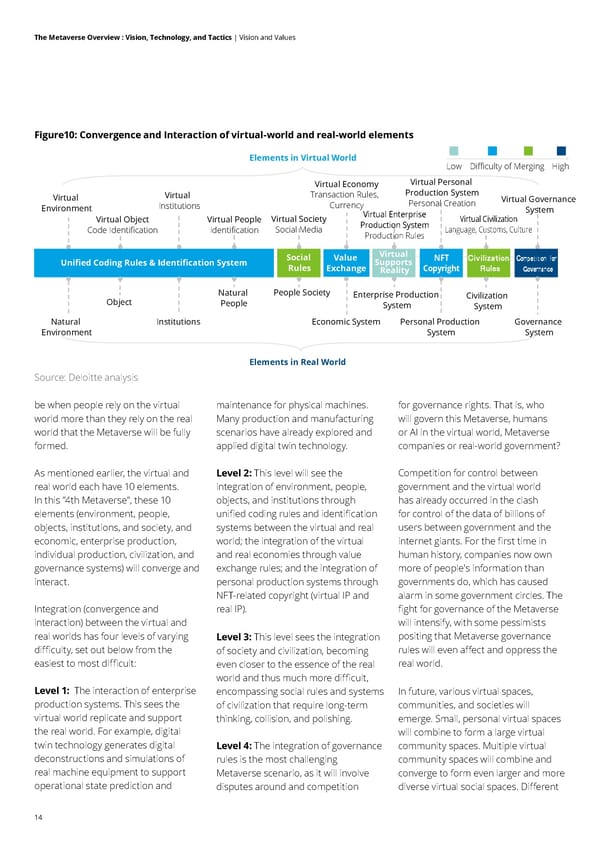14 The Metaverse Overview : Vision, Technology, and Tactics | Vision and Values be when people rely on the virtual world more than they rely on the real world that the Metaverse will be fully formed. As mentioned earlier, the virtual and real world each have 10 elements. In this "4th Metaverse", these 10 elements (environment, people, objects, institutions, and society, and economic, enterprise production, individual production, civilization, and governance systems) will converge and interact. Integration (convergence and interaction) between the virtual and real worlds has four levels of varying difficulty, set out below from the easiest to most difficult: Level 1: The interaction of enterprise production systems. This sees the virtual world replicate and support the real world. For example, digital twin technology generates digital deconstructions and simulations of real machine equipment to support operational state prediction and Figure10: Convergence and Interaction of virtual-world and real-world elements Source: Deloitte analysis maintenance for physical machines. Many production and manufacturing scenarios have already explored and applied digital twin technology. Level 2: This level will see the integration of environment, people, objects, and institutions through unified coding rules and identification systems between the virtual and real world; the integration of the virtual and real economies through value exchange rules; and the integration of personal production systems through NFT-related copyright (virtual IP and real IP). Level 3: This level sees the integration of society and civilization, becoming even closer to the essence of the real world and thus much more difficult, encompassing social rules and systems of civilization that require long-term thinking, collision, and polishing. Level 4: The integration of governance rules is the most challenging Metaverse scenario, as it will involve disputes around and competition for governance rights. That is, who will govern this Metaverse, humans or AI in the virtual world, Metaverse companies or real-world government? Competition for control between government and the virtual world has already occurred in the clash for control of the data of billions of users between government and the internet giants. For the first time in human history, companies now own more of people's information than governments do, which has caused alarm in some government circles. The fight for governance of the Metaverse will intensify, with some pessimists positing that Metaverse governance rules will even affect and oppress the real world. In future, various virtual spaces, communities, and societies will emerge. Small, personal virtual spaces will combine to form a large virtual community spaces. Multiple virtual community spaces will combine and converge to form even larger and more diverse virtual social spaces. Different Virtual Economy Transaction Rules, Currency Virtual Civilization Language, Customs, Culture Virtual Society Social Media Low Difficulty of Merging High People Society Personal Production System Economic System Enterprise Production System Civilization System Governance System Elements in Real World Elements in Virtual World Virtual People Identification Natural People Virtual Institutions Institutions Virtual Environment Natural Environment Value Exchange Virtual Supports Reality NFT Copyright Civilization Rules Competition for Governance Virtual Object Code Identification Object Unified Coding Rules & Identification System Social Rules Virtual Enterprise Production System Production Rules Virtual Personal Production System Personal Creation Virtual Governance System
 Deloitte The Metaverse Overview Page 13 Page 15
Deloitte The Metaverse Overview Page 13 Page 15